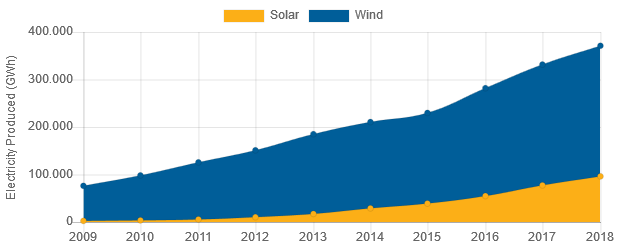Since 2009, the U.S. has increased its solar power generation 40-fold and upped its electric production from wind by more than 270%, according to a new report released by Environment America Research & Policy Center and Frontier Group.

The
study also highlights advances in energy savings, the increased use of
energy storage and the growth of electric vehicle (EV) sales.
Wind
turbines and solar panels were novelties ten years ago; today, they are
everyday parts of America’s energy landscape. As recently as 2010,
energy-saving LED light bulbs cost $40 apiece; today, they cost a few
dollars at the hardware store. Just a few years ago, electric vehicles
seemed a far-off solution to decarbonize our transportation system; now,
they have broken through to the mass market.

Virtually
every day, there are new developments that increase our ability to
produce renewable energy, apply renewable energy more widely and
flexibly to meet a wide range of energy needs, and reduce our overall
energy use — developments that enable us to envision an economy powered
entirely with clean, renewable energy.
America produces almost
five times as much renewable electricity from the sun in wind as it did
in 2009, and currently wind and solar energy provide nearly 10 percent
of our nation’s electricity.
The last decade has proven that
clean energy can power American homes, businesses and industry — and has
put America on the cusp of a dramatic shift away from polluting energy
sources. With renewable energy prices falling and new energy-saving
technologies coming on line every day, states, cities, businesses and
the nation should work to obtain 100 percent of our energy from clean,
renewable sources.
Clean energy leadership
Leadership is
distributed across the United States, in states with different economic
and demographic makeups, driven by a combination of clean energy
attributes and policies that have helped clean energy measures succeed.
Explore the map below to see how your state ranks on their progress to
maximize clean energy technology.
Untapped potential
Rapid
improvements in technology and plummeting prices for clean energy
suggest that America has only begun to tap its vast clean energy
potential.
Nearly every segment of the clean energy market is
experiencing rapid price declines. A National Renewable Energy
Laboratory (NREL) survey of clean energy prices found that, from 2010 to
2018, the cost of distributed PV fell by 71 percent and utility-scale
PV by 82 percent” change 82 percent to 80-82 percent. Lazard, a
consulting firm, found that the cost of land-based wind power fell by 66
percent during the same period. It also reports that renewable sources
like certain wind and solar energy technologies are cost-competitive
with conventional generation technologies. In Idaho, for example, a
record-breaking solar contract was signed in 2019, promising to deliver
energy for $2.18 cents per kilowatt-hour.
In a study by NREL
found that the cost of wind energy is expected to fall 50 percent by
2030 from 2017 cost levels. One study found that in most cases, building
new wind and solar power is cheaper than running existing coal plants.
And renewable energy is only expected to get cheaper. Bloomberg New
Energy Finance predicts that the cost of an average utility-scale solar
plant “falls 71 percent by 2050.” It also estimates that by 2030, energy
storage costs will fall by 52 percent.
Technology advances are
also making renewable energy technologies more efficient and effective.
In 2007, the highest-capacity wind turbine in the world was 6 MW, with
only one such test prototype actually in operation. This summer, General
Electric expects to deploy the first prototype of its massive
“Haliade-X” wind turbine, which has a capacity of 12 MW — enough to
supply annual electricity for nearly 6,500 U.S. homes.
Advanced
new products are also helping to reduce energy consumption. For example,
light emitting diode (LED) lighting uses only a quarter the energy of a
traditional, incandescent light and lasts up to 25 times longer. By
2027, the Department of Energy estimates that LEDs could save 348
terawatts of electricity — equivalent to the annual production of 44
large power plants.
America’s renewable energy resources are
enough to power the nation several times over. The technologies needed
to harness and apply renewable energy are advancing rapidly. And
researchers from a wide variety of academic and governmental
institutions have developed a variety of scenarios suggesting renewable
energy can meet all or nearly all of our society’s needs.
Moving forward
The
U.S. should plan to meet all of its energy needs — for electricity,
transportation and industry — with clean, renewable energy, and put
policies and programs in place to achieve that goal.


